

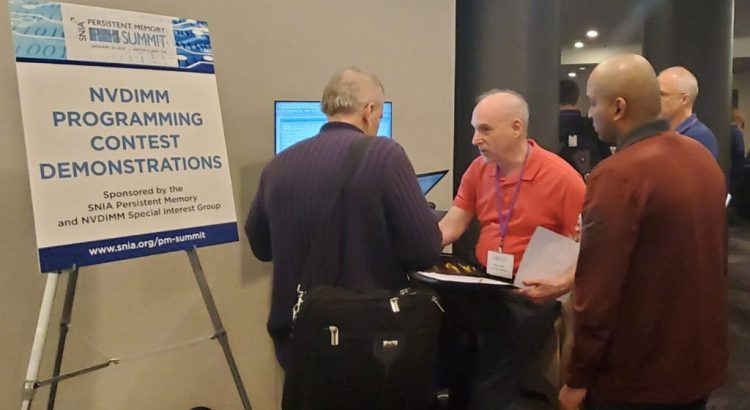
Up to the Challenge!

Pay Attention to These Cloud Standards

Got SPDK Questions?

Why Object Storage is Important
24G SAS Feature Focus: Inherent Scalability and Flexibility
[Editor’s Note: This is part of a series of blog posts discussing 24G SAS features.]
By: Jeremiah Tussey, Vice President, SCSI Trade Association; Alliances Manager, Product Marketing, Data Center Solutions, Microchip Technology, December 12, 2019
Serial Attached SCSI (SAS) and the SCSI protocol are undergoing an evolution, transitioning to 24G SAS and implementing new features and enhancements to a well-established storage technology. SAS has set the bar in the storage industry with inherent scalability and flexibility in modern data center, server and storage topologies. This tested ability carries forward to the latest update in the SAS technology roadmap: 24G SAS.
Unsurpassed scalability
SAS technology addresses a very large and continuously growing market, natively supporting many host connections to thousands of target devices in a single topology. It enables optimized capacity storage solutions and provides interconnect distance that empowers SAS fabric solutions. Today, SAS services cold cloud data centers, high-performance computing and direct server markets. SAS is effectively the persistent storage with flexibility in attached media solutions.
A variety of interconnect solutions support SAS, with copper for short to medium reach, and fiber optics for long reach applications. These cabling options utilize mini SAS-HD and Quad Small Form-Factor Pluggable (QSFP), as well as recent SlimSAS™ and MiniLink definitions added into the latest SAS standard. Additionally, native failover and dual-port features allow multiple domains to be configured and then automatically takeover operations in the case of component failures, broken cable connections or domain failures of any form. These inherent features were built into the protocol with high reliability, availability and scalability (RAS) in mind. Overall, these maintain per-lane performance, data integrity, flexible architectures and a native hot plugging ability to add or remove enterprise servers and storage for decades.
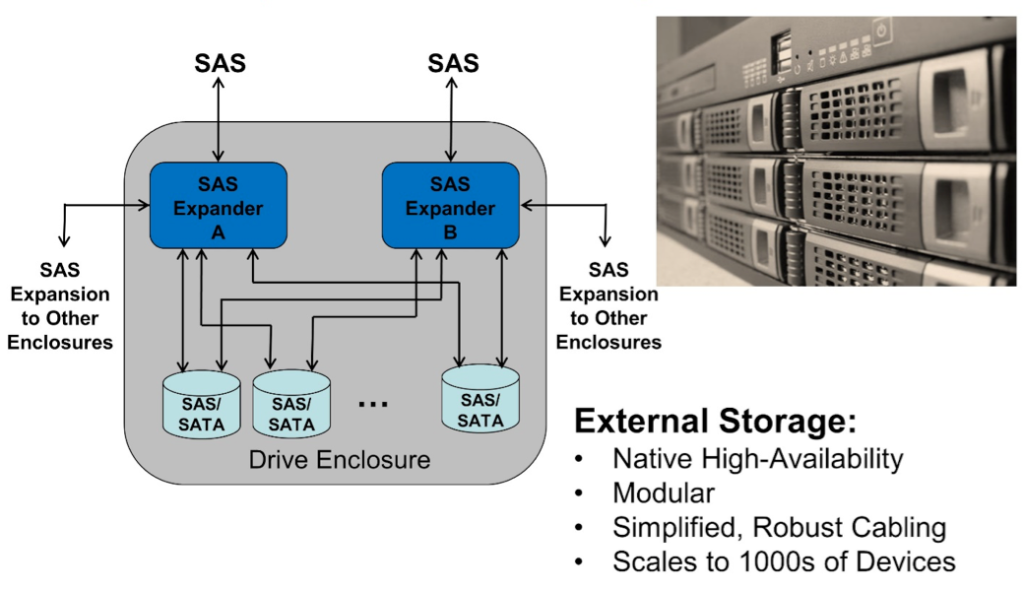
Scalability in External Storage Architectures
Flexibility for the future
What makes this support come all together is the flexibility that is built into SAS. SAS supports simultaneous SAS and SATA end devices, using the Serial SCSI Protocol (SSP) for SAS connections and Serial ATA Tunneling Protocol (STP)for SATA connections. Because SAS technology can support two transport protocols simultaneously, SAS has and will continue to span all storage types. This flexibility allows high-performance SAS SSDs with MultiLink connections for optimized throughput in demanding applications with SAS infrastructure.
Traditional enterprise SAS Hard Disk Drives (HDDs) are still effectively utilized in more practical medium IO-intensive, cost-sensitive applications. With rising use of cost-optimized SAS or SATA SSD alternatives, SSDs are increasingly used in these more IO-Intensive and cost-sensitive applications. SAS has effortlessly enabled that media transition as well. Better yet, SAS enables data centers that are filled with capacity-optimized SAS and SATA HDDs, which still maintain a nearly 10 times cost advantage over NAND Flash-based solutions.
New standards and technology enhancements have been introduced in HDDs to continue supporting the exponential growth in storage demands that cannot be effectively covered with SSD solutions. SMR and hybrid HDD solutions with dynamic configuration only available as a SCSI feature are recent introductions ideal for these capacity-demanding applications. Last but not least, SAS topologies still support backup technologies such as SAS or SATA Tape products, allowing access to historical data storage and continued use of the latest backup solutions based on tape, DVD or Blu-ray backup storage arrays, even in new 24G storage deployments.
SAS Innovations in HDD and SSD Technologies
- SSHD (Solid State Hard Drive) – hybridization of performance and capacity
- Storage Intelligence – SSD optimization, including garbage collection
- TDMR (Two-Dimensional Magnetic Recording) – faster writes
- Helium – capacity optimization
- SMR (Shingled Magnetic Recording) – capacity optimization
- MultiLink – bandwidth
- Multiple Actuator – IOPs per TB
- MAMR (Microwave-Assisted Magnetic Recording) – capacity optimization
- HAMR (Heat-Assisted Magnetic Recording) – capacity optimization
- Hybrid SMR – Configurable SMR vs. standard capacity; helps with SKU management
The ecosystem is on track for 24G SAS production readiness for the upcoming deployment of next-generation server platforms. Analyzers and test equipment have been available for some time now, with cables and connectors in existing and new form-factors ready for 24G SAS. Next-gen SAS controller and expander products are aligned with upcoming PCIe Gen4 platform launches. New 12G SAS and 6G SATA HDD/SSD capabilities to intersect with 24G SAS ecosystem include: MultiLink SAS™ SSDs and Dual-actuator HDDs for increased IOPs/Bandwidth, hybrid SMR for flexible and increased capacity, as well as HAMR / MAMR technologies for increased capacity. SAS continues to evolve through innovation, targeting enhanced performance and features and continuing inherent scalability and flexibility support in modern data center server and storage topologies.
 SAS – Preserving the Past, Creating the Future
SAS – Preserving the Past, Creating the Future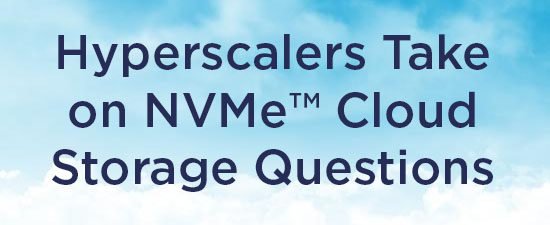
Hyperscalers Take on NVMe™ Cloud Storage Questions
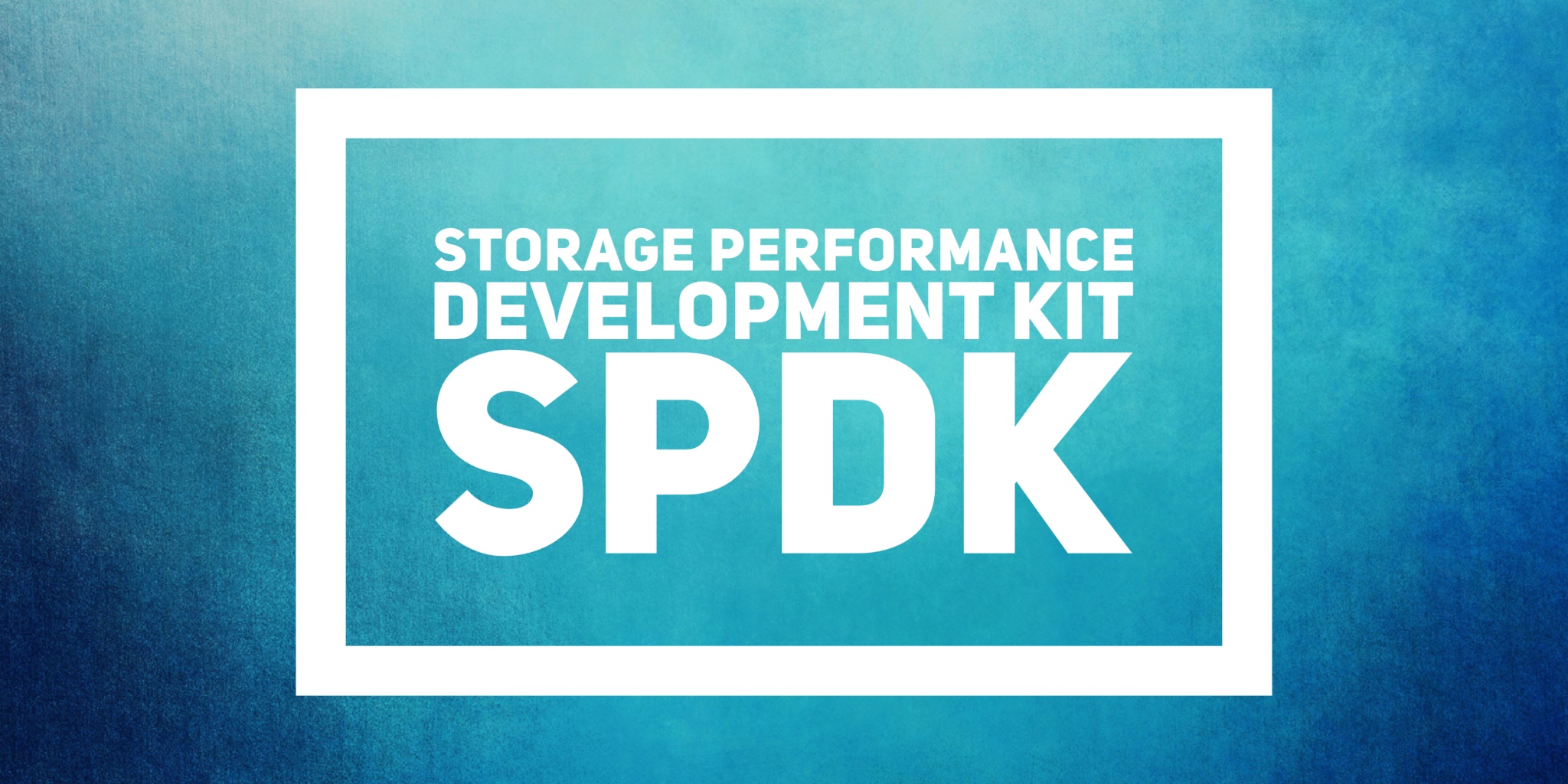
SPDK in the NVMe-oF™ Landscape
 . This includes software drivers and libraries for building NVMe over Fabrics (NVMe-oF) host and target solutions. On January 9, 2020, the SNIA Networking Storage Forum is going to kick-off its 2020 webcast program by diving into this topic with a live webcast “Where Does SPDK Fit in the NVMe-oF Landscape.”
Read More
. This includes software drivers and libraries for building NVMe over Fabrics (NVMe-oF) host and target solutions. On January 9, 2020, the SNIA Networking Storage Forum is going to kick-off its 2020 webcast program by diving into this topic with a live webcast “Where Does SPDK Fit in the NVMe-oF Landscape.”
Read More
SAS Lives On and Here’s Why
By: Rohit Gupta, Enterprise Segment Management, Western Digital
In the Zettabyte Age, data is the new lifeline. Data is transforming anything and everything at an unprecedented rate in the globally connected world. Businesses are constantly looking for new ways of collecting, storing, and transforming various forms of data to extract intelligence for better decisions, improve processes and efficiencies, develop technologies and innovative products, and ultimately maximize business profitability. Read More
Judging Has Begun – Submit Your Entry for the NVDIMM Programming Challenge!
We’re 11 months in to the Persistent Memory Hackathon program, and over 150 software developers have taken the tutorial and tried their hand at programming to persistent memory systems. 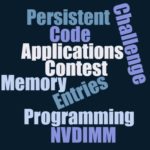 AgigA Tech, Intel, SMART Modular, and Supermicro, members of the SNIA Persistent Memory and NVDIMM SIG, have now placed persistent memory systems with NVDIMM-Ns into the SNIA Technology Center as the backbone of the first SNIA NVDIMM Programming Challenge.
AgigA Tech, Intel, SMART Modular, and Supermicro, members of the SNIA Persistent Memory and NVDIMM SIG, have now placed persistent memory systems with NVDIMM-Ns into the SNIA Technology Center as the backbone of the first SNIA NVDIMM Programming Challenge.
Interested in participating? Send an email to PMhackathon@snia.org to get your credentials. And do so quickly, as the first round of review for the SNIA NVDIMM Programming Challenge is now open. Any entrants who have progressed to a point where they would like a review are welcome to contact SNIA at PMhackathon@snia.org to request a time slot. SNIA will be opening review times in December and January as well. Submissions that meet a significant amount  of the judging criteria described below, as determined by the panel, will be eligible for a demonstration slot to show the 400+ attendees at the January 23, 2020 Persistent Memory Summit in Santa Clara CA.
of the judging criteria described below, as determined by the panel, will be eligible for a demonstration slot to show the 400+ attendees at the January 23, 2020 Persistent Memory Summit in Santa Clara CA.
Your program or results should be able to be visually demonstrated using remote access to a PM-enabled server. Submissions will be judged by a panel of SNIA experts. Reviews will be scheduled at the convenience of the submitter and judges, and done via conference call.
NVDIMM Programming Challenge Judging Criteria include:
Use of multiple aspects of NVDIMM/PM capabilities, for example:
- Use of larger DRAM/NVDIMM memory sizes
- Use of the DRAM speed of NVDIMM PMEM for performance
- Speed-up of application shut down or restart using PM where appropriate
- Recovery from crash/failure
- Storage of data across application or system restarts
Demonstrates other innovative aspects for a program or tool, for example:
- Uses persistence to enable new features
- Appeals across multiple aspects of a system, beyond persistence
Advances the cause of PM in some obvious way:
- Encourages the update of systems to broadly support PM
- Makes PM an incremental need in IT deployments
Program or results apply to all types of NVDIMM/PM systems, though exact results may vary across memory types.
Questions? Contact Jim Fister, SNIA Hackathon Program Director, at pmhackathon@snia.org, and happy coding!